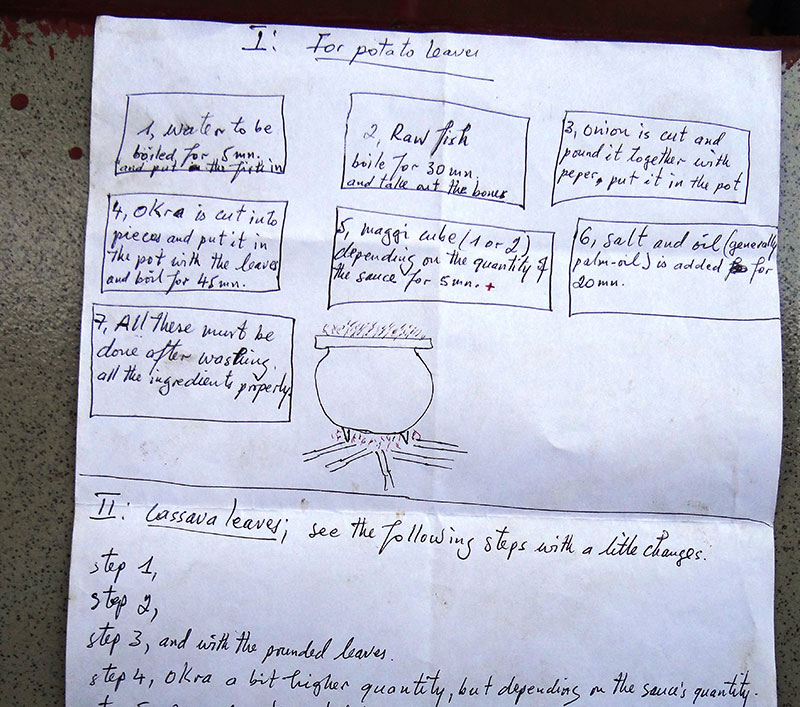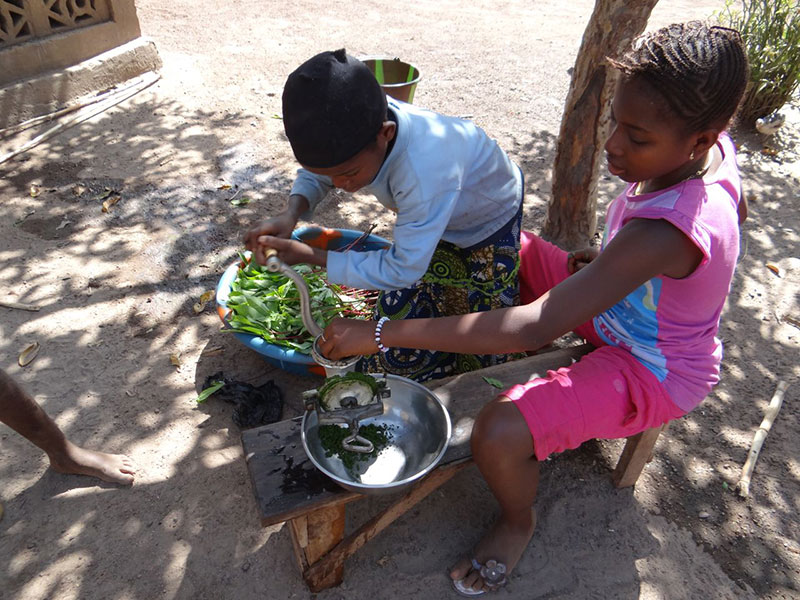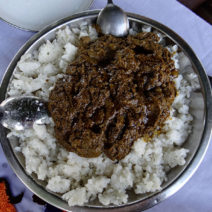African Stewed Yam Leaves (Sweet Potato Leaf Recipe)
Are sweet potato vines edible? Absolutely! I (Judy, one farmer behind Shepherd Song Farms) was introduced to sweet potato leaves (also referred to as camote tops) in cooking while instructing on sheep and goat nutrition in Bilasso Mali and Guinea in June 2013. Sweet potatoes, along with groundnuts (peanuts) and cassava are very common crops throughout tropical Africa.
Sweet potato vines are perfect food for newly weaned lambs and goat kids as the nutrient levels are very similar to small ruminant milk and easily digested. But, while the village shepherds in southern Mali commonly use excess sweet potato vines for animal feed and transport it in huge heaps on back of motorbikes, sweet potato leaves are too valuable to the Guinea villagers I worked with to be considered for animal feed.
Sweet potato vines (yam leaves) are a nutritious leafy green, and a source of protein, vitamin A, thiamine, riboflavin, niacin, lipids, essential minerals and nutrients such as calcium, phosphorus, magnesium, sodium, potassium, sulfur, iron, copper, zinc, manganese among other nutrients. Cassava and groundnuts are also popular as they grow well in poorer soils and dryer conditions. Cassava leaves and groundnut vines are cooked similarly to sweet potato vines but cassava contains a toxin in both the leaves and tubers so it needs to be handled a little differently during the preparation process and the water from the leaves discarded.
For this goat meat stew recipe, the young, green leaves of sweet potatoes can be substituted with cassava leaves (see photo below) or peanut vines. Most American grocery stores don’t carry yam greens. You’ll want to check an Asian grocer or African grocer. The raw fish can be substituted with fish stock and the ground peanuts with peanut butter—or follow the traditional method to experience the unique flavors. If making a stew sounds like too much work, the greens can also be cooked quickly as with Chinese stir-fried sweet potato leaves.
Exact measurements for the goat meat stew recipe are difficult to obtain as it depends upon availability, the occasion and the judgment of the cook. The addition of meat may be standard for some families and rare for others. Lamb meat is generally the most highly valued for special feasts. Chicken, fish, goat, and beef are used more routinely.
Related Posts
African Stewed Yam Leaves (Sweet Potato Leaf Recipe)
Equipment
- 1 Dutch oven or medium-sized stew pot.
Ingredients
- 1 lb goat meat (traditionally bone-in stew meat but lamb, beef or chicken or no meat can be used).
- Raw fish substitute: 2 Tbs fish stock.
- 2 lb young sweet potato leaves finely chopped or pounded in a mortar (substitute: peanut vines, cassava or other coarse greens).
- 2 large yellow onions finely chopped or pounded.
- 1 leek finely chopped or pounded.
- 2 green pepper finely chopped or pounded.
- 1 eggplant diced.
- 4-6 okra diced.
- 1-2 red hot peppers - whole.
- 3 Tbs palm oil vegetable oil or olive oil
- 1 Tbs lemon juice
- Salt and black or white pepper to taste.
- Optional: ½ C peanuts finely ground– skins off (substitute: peanut butter).
- Optional: other vegetables as available.
Instructions
Sweet potato leaves
- Wash the sweet potato leaves (substitute peanut or cassava leaves) and remove them from the stems.
- Finely chop the leaves with the leek, onions and green peppers or pound in a mortar.
- Bring a pan of salted water to a boil, add the mixture and boil for about 30 minutes, or until tender. Thoroughly drain and rinse if using cassava leaves. Set aside.
Fish and goat meat
- While boiling the greens in the previous step: 1) boil the raw fish for 30 minutes, then remove the fish bones and reserve the fish stock and flesh; 2) brown the goat meat.
- In a large pot or casserole add the goat meat, oil, okra, eggplant pieces, green pepper & red (hot) pepper to the fish sauce and flesh. Add water to completely cover.
Cook and finish the stew
- Bring to a simmer, cover and cook for about an hour over medium heat until the meat is tender. Add additional water if necessary.
- Add salt and pepper to taste.
- Add lemon juice before serving.
- Optional: Add ground peanuts (or peanut butter mixed with a little hot water). Continue cooking for another few minutes.
- Ladle over rice, millet or couscous. Place meat chunks on top. This is traditionally eaten from one common bowl placed in the center of the table.
Serve the stew
- Ladle over rice, millet or couscous. Place meat chunks on top. This is traditionally eaten from one common bowl placed in the middle of the table so all can reach.
Notes





